Sometimes known as Japanese or Siamese fighting fish, bettas are beautiful, vibrant fish. They are often seen in smaller individual tanks due to the fact that they are quite territorial.
The thing that most people tend to notice first about betta fish is their flamboyant tails and bright colorings.
Captive bred bettas tend to have brighter, more vibrant colorings because they have been specifically bred from brightly colored parents. Their wild cousins only really display colors when they’re trying to mate or trying to look threatening.
Bettas get their coloring and patterns from their parents and from their food. This is because betta fish don’t naturally produce many pigments. This means that to keep your bettas looking beautiful, you need to feed them a healthy and varied diet.
While many people tend to class all betta fish as the same breed, there are actually quite a few different breeds. They can be distinguished by the tails, colors, and patterns, which vary from breed to breed.
We’re going to take a look at the different breed betta fish you can find and show you how to distinguish them from each other!
Breeds can be identified by their tail shape, their colors, or their patterns. In some cases, all three elements combine to make a unique betta fish.
Here is the Betta Fish List - Look for the Tail Shape!
These bettas can be identified by their tails. The overly large, often dramatic, tails have been selectively bred into these fish. Wild bettas have much smaller, more practical tails.
Below is the complete list of betta fish, including custom graphics that not only show the type of betta fish, but their tank requirements too and a general overview too!
1. Plakat Betta – Betta splendens var. Plakat
These bettas are probably the most similar to their wild cousins. The Plakat betta has a short, rounded tail. It doesn’t droop or splay out.
In fact, the tail is so low key that many people mistake these bettas for females. This is because female betta fish are smaller and more modest.
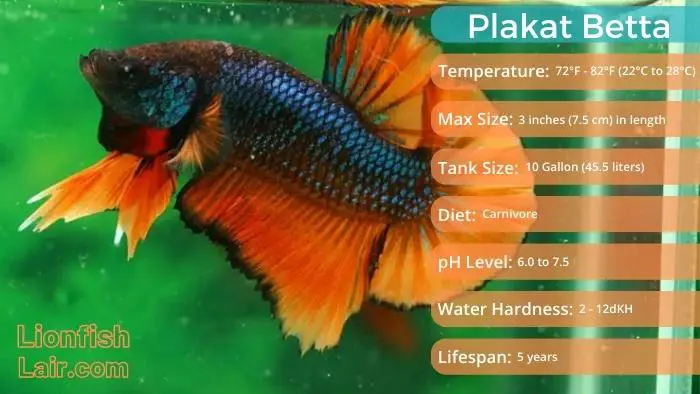
The Plakat betta is speedy because it is not being held back by a flowing tail. This allows them to get some serious air when they use their speed to propel themselves out of the water.
Unless you want an acrobatics show, you really need to keep a solid lid on tanks with Plakat betta fish.
2. Spade Tail Betta – Betta splendens var. Spade
The spade tail betta is so named for the tail fin that resembles the head of a spade. It is rounded at the base, but it tapers to a point at the end.
Sometimes confused for a rounded tail betta, the taper at the end of the tail is the defining feature of this fish.
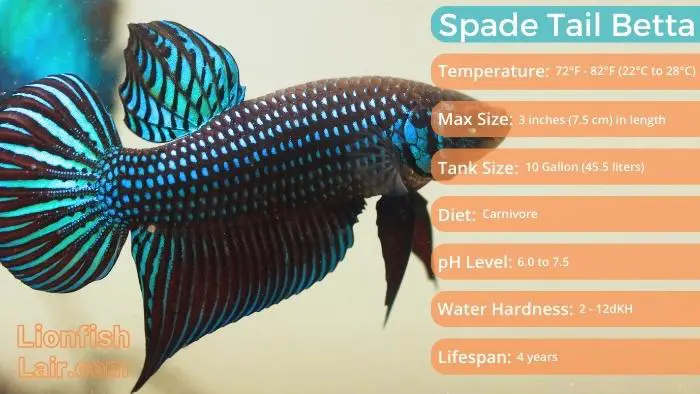
Spade tails are also pretty quick. This is because their tail is less flowy and droopy than other varieties. This reduces the amount of drag on the fish as it swims.
The spade tail variety of betta is generally considered to be one of the healthiest. It doesn’t suffer from conditions like tail rot or tail biting as much as other varieties.
3. Round Tail – Betta splendens var. Round
This variety is also known as the single tail or fan tail betta. They have a single tail that fans from the top of the body down to the base of their body.
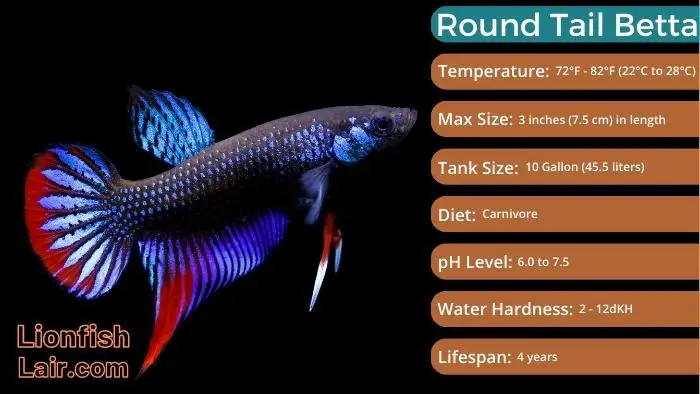
Again, this variety is less flowy and showy than others, which makes it quite a fast swimmer. If you’re going to keep round tail bettas, you need to make sure you have a secured lid on your aquarium.
Round tails are fairly easy to come by, you’ll often see them in big box pet stores as well as on sale from breeders.
4. Halfmoon – Betta splendens var. Halfmoon
Halfmoons are sometimes confused for round tail bettas because the ends of their tails are round. The difference is seen in the part that joins to the body.
In the halfmoon, the body end of the tail has two straight sides, making the tail look more like a capital D shape.
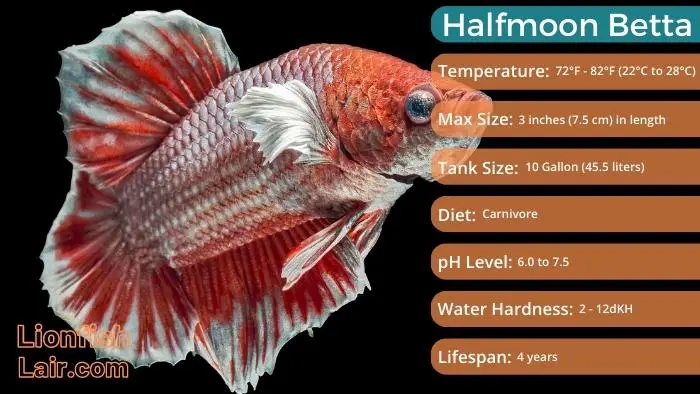
The other defining feature of halfmoons is their elongated dorsal and anal fins. These are a bit of a by product from the selective breeding.
Other by products of intensive selective breeding include increased aggression and a proclivity for ‘blowing a tail.’
When a betta ‘blows a tail’ they rip it. This can happen during an altercation with another fish or accidentally as they go about their lives. A ripped tail is quite a problem because it can become infected.
5. Delta – Betta splendens var. Delta
These bettas are similar to halfmoon bettas, but their tail doesn’t fan out as much. Instead of looking like a ‘D’ shape, their tail looks triangular when fully extended. This is how they got their name, as the Greek letter ‘delta’ looks like a triangle.
You can also get super delta betta fish. These have a slightly larger tail that can extend out almost 180 degrees.
Super bettas are quite similar to halfmoon bettas. It can be almost impossible to tell them apart because they both have 180-degree tails.
Both delta and super delta betta fish are pretty healthy fish. They are not overly prone to fin rot or blowing a tail.
6. Double Tail – Betta splendens var. Double
The double tailed betta is a result of a mutation where the fish has two caudal penduncles. These are tapered regions of the body where the tail fine attaches to.
The two tails aren’t always identical. Like we said, this kind of tail is a mutation, which means that the tail sizes and shapes are quite random.
For show bettas, the more similar the two tails the better. This means that double tail bettas can become quite expensive if you’re looking for a show quality double tail.
The other thing to be aware of is that double tail betta fish are quite sickly. They’re prone to typical betta illnesses like fin rot and blowing a tail. They’re also prone to swim bladder disorder.
7. Combtail – Betta splendens var. Combtail
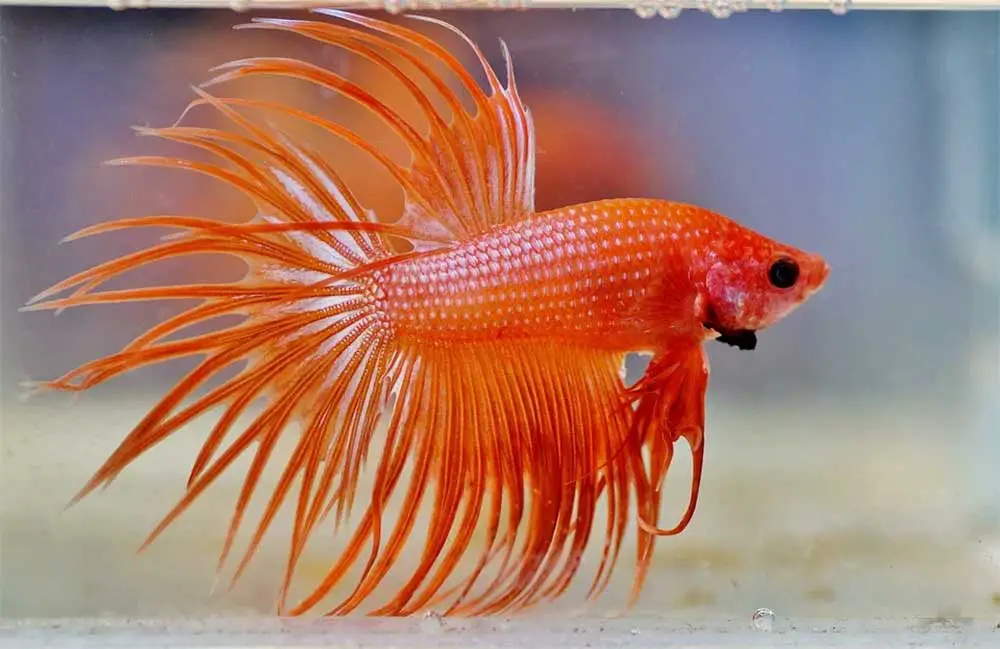
Combtail bettas get their name from the fact that their tails look like a wide tooth comb. This effect is achieved by the arrangement of the tail rays and webbing.
The rays are the stronger, almost spiny part of the tail. They’re the ridges you see on the betta’s tails. The rays are joined by softer tissue called webbing.
In a combtail betta, the webbing only reaches two thirds of the way up the rays. This leaves the ends of the rays exposed, which makes them look like the teeth of a comb.
These are pretty healthy bettas, though they do sometimes suffer from droopy tails. This doesn’t affect their health, but they do look a bit odd.
8. Crowntail – Betta splendens var. Crowntail
These are similar to the combtail bettas. The difference is in the length of the webbing.
In a crowntail, the webbing is less than two thirds of the length of the ray. This gives the tail a really spiky appearance.
Crowntails are healthy fish. Thanks to the reduced size of their webbing, they don’t suffer from tail rot or tail biting as much as other varieties.
They do sometimes end up with broken rays which gives the tail a messy, droopy, or disordered look. It is not harmful, but it does detract from the otherwise impressive looking fish.
9. Rosetail – Betta splendens var. Rosetail
These are at the opposite end of the spectrum from crowntails and combtails. Rosetail betta fish have lots of branched rays joined by flowing, ruffled webbing.
The fish gets its name from the fact that the bunched tail looks like the petals of a rose. It is a beautiful fish with a beautiful tail and a beautiful name.
Unfortunately, these showy and flowy tails are prone to tail rot, while the fish are prone to tail biting. We’re not sure why bettas engage in tail biting, but we do know that it causes infection and loss of the entire tail.
These fish are also prone to swim bladder disease thanks to extensive over breeding.
10. Feathertail – Betta splendens var. Feathertail
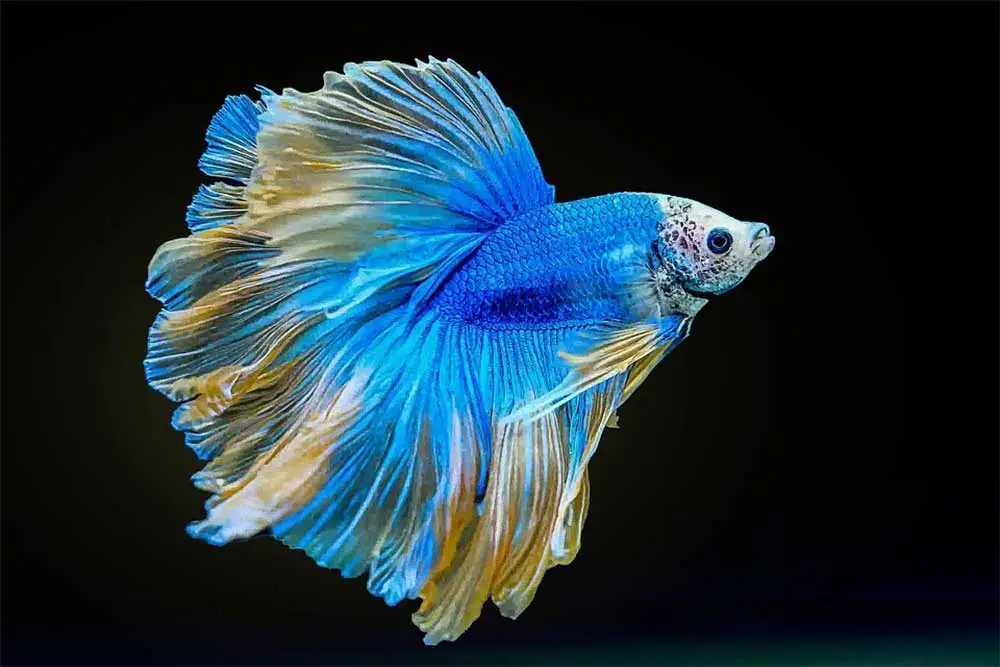
Feathertails are closely related to rosetails. They have one of the most beautiful and flashy tails of all betta fish.
The webbing of the feathertail’s tail gracefully arcs from ray to ray, creating rounded points. This gives it a feather-like appearance. The tail is similar to a feathered shuttlecock used in badminton.
These bettas are prone to tail biting and tail rot due to the large and extravagant tails. They are also predisposed to swim bladder disease as a result of intensive breeding.
11. Veiltails – Betta splendens var. Veiltail
Veiltails are the betta fish that you are most likely to see in the pet store. This is because the veil tail is a result of dominant genes, which makes them one of the easiest varieties to breed.
These fish have long, droopy tails that flow like a veil behind them. This is where they get their name from.
When fully splayed, the tail is not symmetrical. You won’t notice this, however, because they don’t naturally splay out their tails.
One of the downsides to the beautiful, flowing tail, is the drag. These tails are not streamlined in the slightest, making the veiltail one of the slowest betta fish.
Veiltails are not considered show fish and aren’t accepted in shows. They are immensely popular pet fish, though.
12. Elephant Ears – Betta splendens var. Elephant Ear
Technically, this variety is not distinguished by their tails. Instead, they are distinguished by their oversized pectoral fins.
The pectoral fins are the fins found on either side of the body. They look like the fish equivalent of arms.
In elephant ear bettas, the pectoral fins are wider and longer than other bettas. This makes them look like Dumbo the elephant, which is where they get their names. In fact, they are sometimes referred to as Dumbo bettas.
Many people prefer to keep female dumbo bettas. This is because neither the males nor females have particularly fancy tails. This makes the males appear quite tame and drab compared to other betta varieties.
The Dumbo females tend to stand out compared to other female bettas thanks to the larger pectoral fins. Drab tails are commonplace in female bettas, so there isn’t anything to draw attention away from the pectoral fins.
Colors
Betta fish are available in a wide variety of colors. They are one of the most diverse and beautiful fish when it comes to their coloring.
Betta colors are determined by the 4 color cell layers that make up the scales. In domesticated bettas, the layers are as follows:
- Iridescent layer (top)
- Black layer
- Red layer
- Yellow layer (Bottom)
Each layer is controlled by different genes, which means that you get different strengths and depths of color across each layer. The final overall color of the betta fish is a result of these cells layered on top of each other.
The following colors can be found in fish with any of the above tail shapes.
1. Red – Betta splendens var. Red
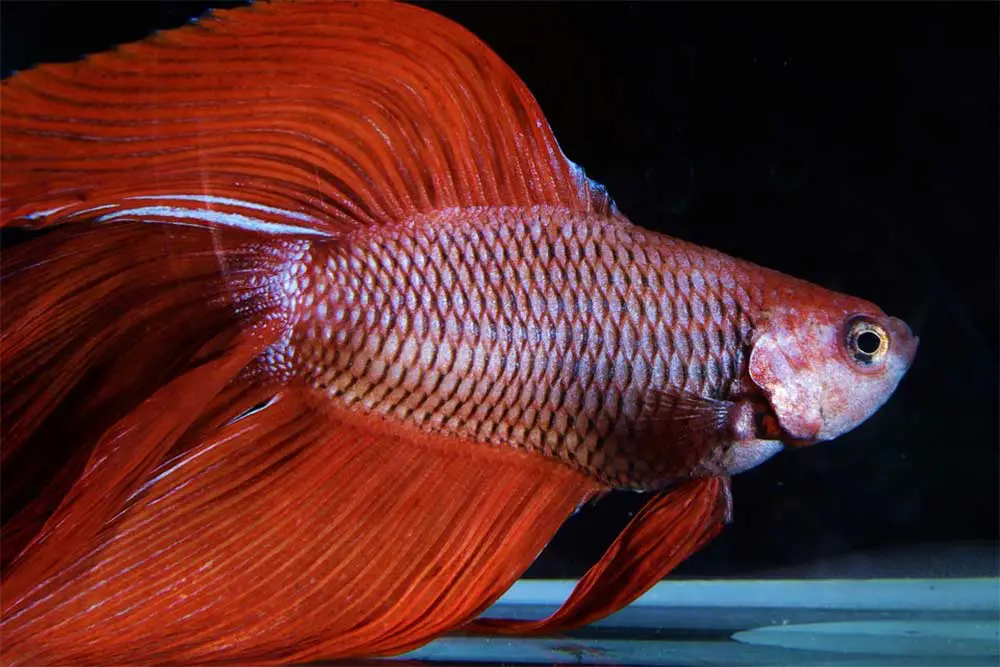
Red is the dominant color gene in betta fish. This means that it is one of the most common colors you’ll see in betta fish.
In fact, the gene is so dominant that you often see red washed through other colors of betta fish, highlighting the fin ends or tails.
2. Blue – Betta splendens var. Blue
Blue isn’t a very common color in nature, but it is common in betta fish.
The blue color is created in the iridescent layer of the scales. It is not caused by pigment, but by the shape of the scales. Differently shaped iridescent scales reflect light in different ways, which is how you can get different shades of blue.
Another thing that affects the blue hue is the amount of black pigmentation in the black layer of cells. The blacker in the second layer, the deeper and richer the blue color will be.
Generally, there are 3 agreed upon blue colorings. They are:
- Steel blue
- Royal blue
- Turquoise blue
Steel blue bettas are the most common of the colors and is created by combining gray and blue cells. The royal blue has a rich, vibrant blue hue and is moderately common. Turquoise blue fish have a lovely greenish blue color and are less common than other blue colors.
3. Green – Betta splendens var. Green
Green bettas are somewhat deceiving in that the green isn’t always immediately visible. This is down to the fact that the green is created by the iridescent cells. In particular it is caused by cells called spread iridocytes.
Spread iridocytes are responsible for creating the metallic sheen that shows up as green under certain light. Green bettas have lots of these cells, but the color is only visible when they reflect light. For this reason, green bettas may appear brown, black, or blue in low light.
4. Copper – Betta splendens var. Copper

Just like the green bettas, copper bettas have those spread iridocytes to blame for their color. The copper color is highlighted when light reflects off their scales.
In low light, these fish look brown or black. However, under light they sparkle with metallic iridescence.
5. Orange – Betta splendens var. Orange
Orange bettas are not particularly common. This is because the red gene is so dominant that it often overpowers the orange tones.
If you do come across an orange betta, you’ll be able to identify it by it’s bright tangerine coloring. It is similar to a goldfish in color, though some might be a paler, blush color.
6. Yellow – Betta splendens var. Yellow
Yellow bettas are quite rare and difficult to breed. This is because the yellow is caused by a lack of or limited pigmentation in the top 3 layers of the cells. The genes that produce no colors in the cell layers is a rare recessive gene, so it is less likely to happen.
When you do spot a yellow betta, you’ll notice that there is quite a wide range of yellow coloring. Some are pastel yellow to a bright buttercup yellow.
These bettas are absolutely stunning. They make an excellent addition to any aquarium.
7. White – Betta splendens var. White
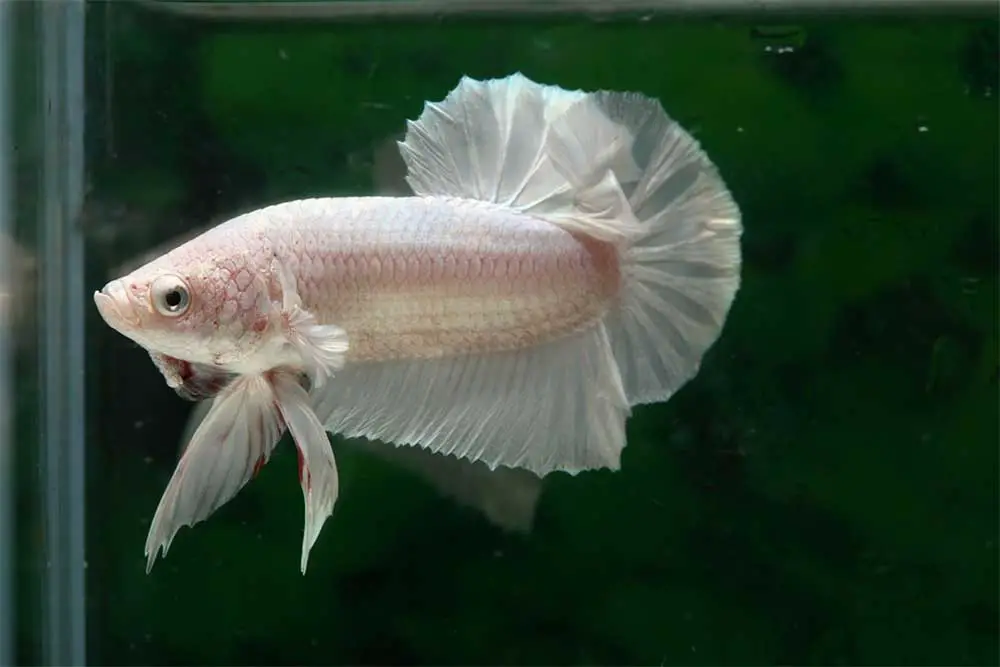
When compared to the brilliantly colorful bettas, a white fish might look a bit plain. However, there is a dainty beauty to white betta fish.
The white body and fins highlight the details of the fish, like the individual scales and tail rays. These are often hidden or lost on the colorful bettas.
White bettas should not have a pinkish hue. This is a feature reserved for albino and cellophane bettas.
8. Black – Betta splendens var. Black
There are a few different kinds of black betta fish that can be created by breeding bettas of specific colors.
Black melano bettas are genetic abnormalities. They are the opposite to albino bettas in that they have too much melanin pigmentation. This gives them a deep, pure black coloring.
Due to their abnormality, these bettas are usually infertile and have a raft of health problems.
Black lace bettas have very dark bodies, but not as dark as black melano bettas. Their fins and tails are usually partially cellophane colored. This variety are fairly common.
Black copper bettas are incredibly rare. This is because they are produced by a fertile black melano female and a copper male betta. Not only do you need to find a black melano betta, which are rare due to the fact that they are genetic mutations, but you also need to find a fertile one.
The black copper bettas have a deep black coloring with a metallic, copper, iridescent wash over the top.
9. Albino
Albino bettas are incredibly rare, to the point that they don’t usually class as a variety in their own right.
Like other albino creatures, an albino betta completely lacks any pigmentation. This gives them a dull white color with a pinkish hue in certain areas.
Albino bettas are different to white betta fish, as they are a result of no pigmentation. White betta fish do have pigments that come together to create a white color.
The problem with albino bettas is that they are incredibly unhealthy. The mutation that makes them albino also gives them a raft of health conditions including infertility, blindness, and cancer.
If you do want a white fish in your tank, buy a white betta instead of an albino. It is kinder on the fish, and they will last longer.
10. Cellophane
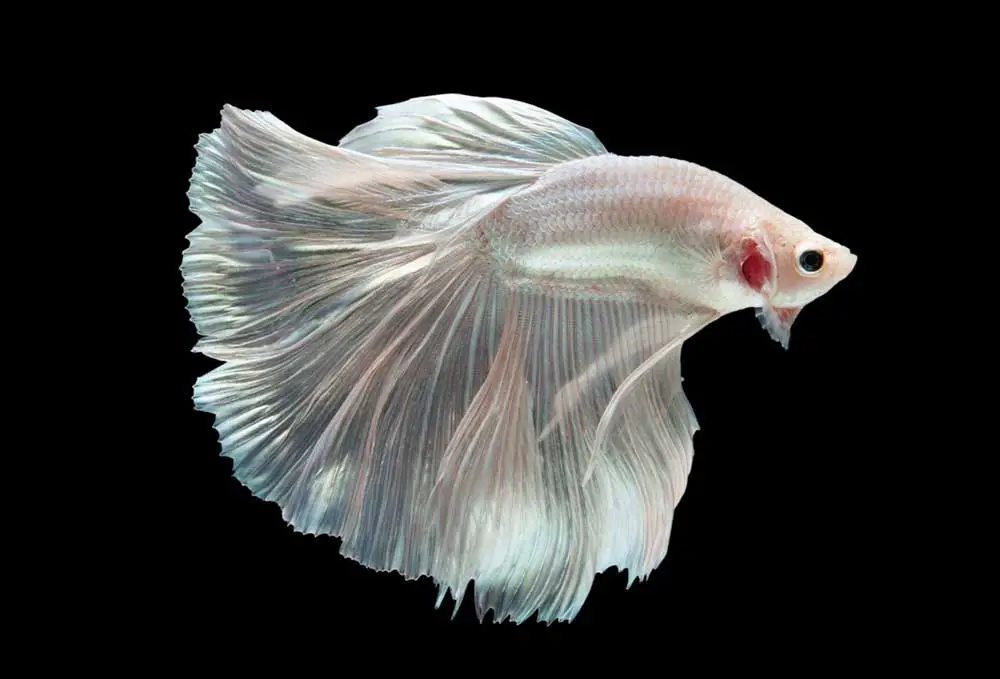
These fish are named because they appear clear like cellophane. This is caused by an almost complete lack of pigmentation. What they do have, however, is those spread iridocyte cells. This prevents them from being albino.
Cellophane bettas will have a whitish coloring, which may appear pink thanks to the muscles and internal organs. The fins and tail will be nearly transparent.
11. Purple
Purple betta fish are incredibly rare. They are so rare that many collectors actually doubt their existence. These people argue that they are simply blue bettas with a bit of red wash.
True purple betta fish will be the most expensive bettas around. Lavender and violet coloring are slightly more common, but they are still incredibly rare and expensive.
Patterns
The third and final variant in betta fish is the patterning. This refers to the markings caused by differently colored scales. Bettas come in lots of different patterns, from one colored block pattern to beautifully complex butterfly patterns.
1. Solid
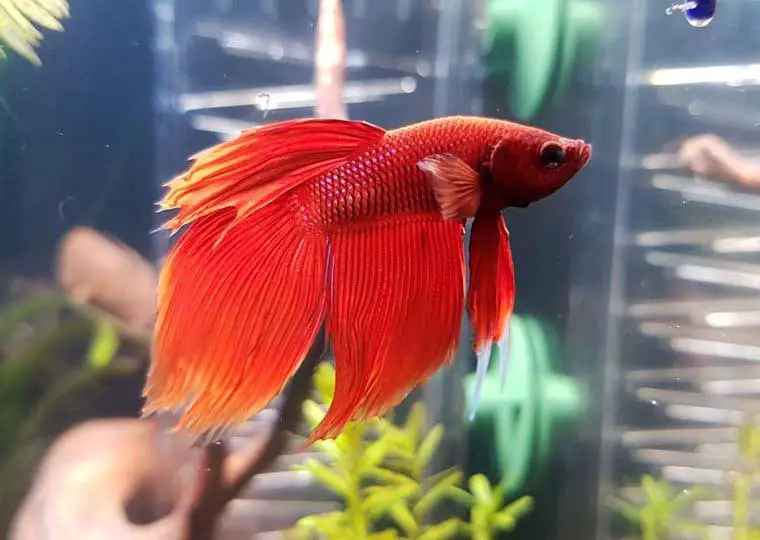
Solid betta fish are one color over their whole body, fins, and tail. They are striking looking fish that make an excellent addition to your tank.
Solid bettas are typically available in the standard colors of red, blue, orange, turquoise/green, yellow and white.
2. Bi-color
As the name suggests, these fish have two different colors. The body will be a different color to the fins and tail.
Any colors are acceptable, though contrasting colors are most popular in show fish. Blue and yellow, blue, and red, and white and red are commonly seen pairings in bi-colored bettas.
There are a few specific sub varieties of betta that are technically bi-colored. The chocolate betta, for instance, is a bi-colored fish with a chocolate brown body and yellow tail.
While not yet recognized as a variety in its own right, the chocolate betta is becoming increasingly popular.
Pineapple is a bicolor pattern seen in yellow bettas. These fish have a darker, usually black, edging to their fins and their tails. This is said to resemble a pineapple, which is where they get their name.
3. Tricolor or Multicolor
These fish have an uneven mix of colors across their bodies and fins. The pattern is random and difficult to predict when breeding.
Tricolor bettas have three colors across their body, while multicolor bettas have more than three colors.
4. Cambodian
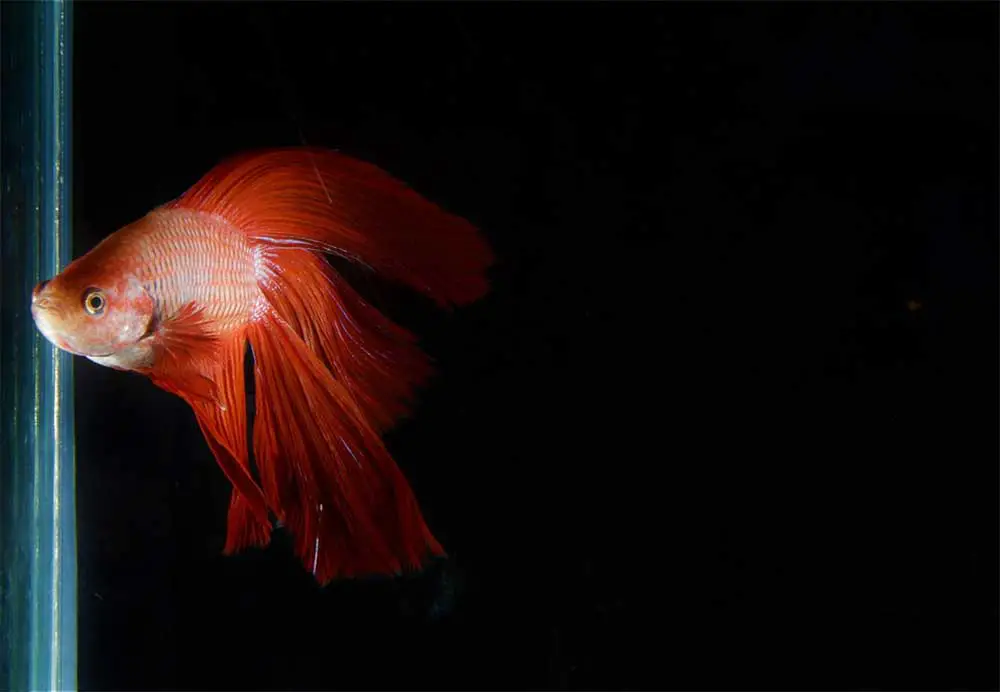
The Cambodian betta fish is a specific variety of bicolored bettas. It has a pink, almost flesh colored body and vibrant red fins and tails.
This pattern came about thanks to selective breeding of light bodied bicolor betta fish. It is now an extremely popular pattern.
Sometimes the fins and tail may be a color other than red. This is pretty rare but accepted by breeders and shows. The key to the Cambodian betta is the fleshy, pink body.
5. Thai Flag
Betta fish that contain the three colors of the Thai flag are highly prized in Thailand, where betta fish originate.
These fish have red, white, and blue colors, usually in a butterfly pattern. They may also have a random tricolor pattern or a marble pattern.
Thai flag bettas have sold for over $1000!
6. Butterfly
Bettas with a butterfly pattern will have two or three different colors evenly split across the body. This means that if you have a 2-color butterfly, half the fish will be one color and the other half will be the other color. In 3 colored butterfly bettas the fish is split in thirds.
The colors shouldn’t bleed into one another. Instead, there should be a clear distinction between one color and the next.
7. Dragon Scale
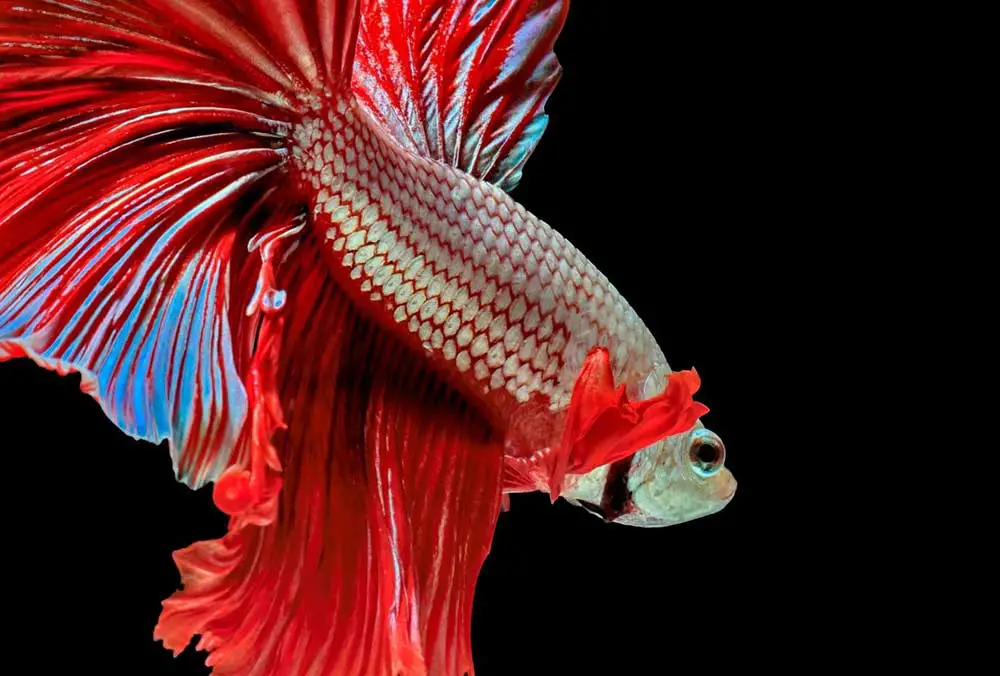
These betta fish are fairly new, but they are wonderful to look at. The iridocyte cells display their metallic colors prominently in these kinds of bettas giving them a shiny, metal finish.
The other thing that sets these bettas apart is the increased scale size and definition. Ideally, you should be able to see each and every scale on these fish.
The clearly defined scales are reminiscent of lizard scales, which is where they get their name from.
Dragon scale bettas may display other patterns on top of the scales, or they can be solid colors.
8. Dalmatian
Just like the dalmatian dog, dalmatian bettas are spotted or speckled.
Bettas with a dalmatian pattern come in lots of different colors, not just black or white. Orange dalmatian bettas are particularly common. These fish have pale orange bodies with darker orange or red spots.
9. Marble
Marbled bettas have a randomized, splotchy pattern that resembles marbled work surfaces and the like.
Interestingly, the marble pattern doesn’t show up right away. It appears randomly over the fish’s life when its primary color darkens in patches and lighter patches begin to develop.
Due to the way marble patterns occur, these fish usually have two or three different colors. You’ll have the original color, the darkened color, and the white splotches.
10. Koi
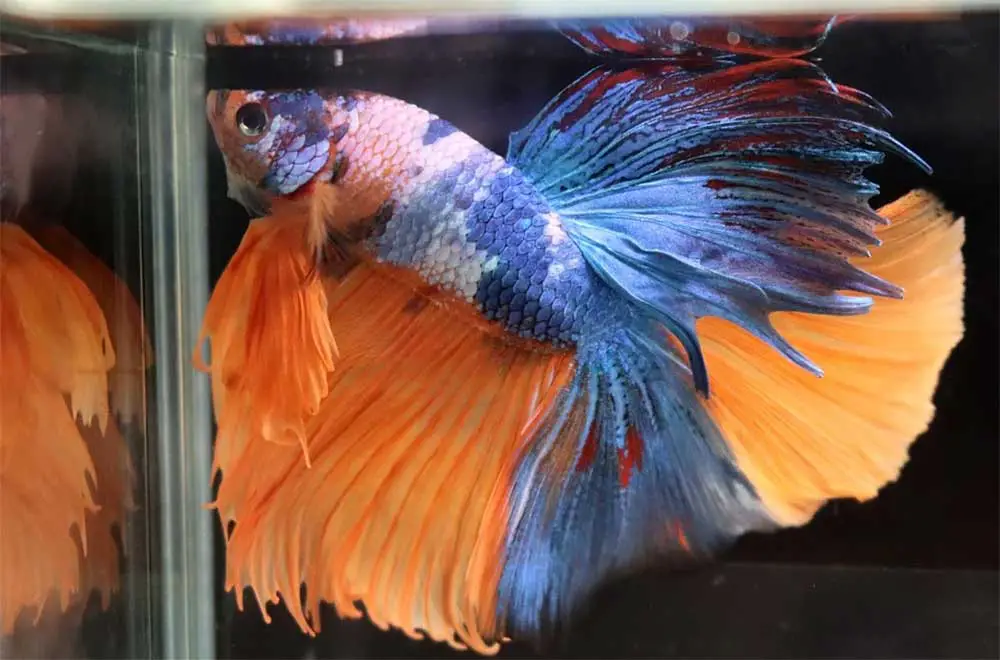
Koi bettas are a type of marble betta, but as the name suggests, they resemble Koi fish in their coloring. You’ll see white, black, and orange in these fish.
11. Grizzle
Grizzle bettas are works of art. They are some of the most beautiful fish you’ll ever see.
Grizzle bettas have two colors, one light and one dark. Sometimes they’ll have two different shades of a color instead of two different colors.
What makes them unique is the way the colors are displayed. Unlike bi-color bettas, the split between the two colors is not defined. Instead, the colors look like they have been painted on the fish with a fine brush.
Grizzle bettas look like a work of art. You can almost believe that they have been painted on the tank.
12. Piebald
Piebald bettas will have a white or unpigmented head but a colorful body, fins, and tails.
Unlike in other piebald animals, bettas with this pattern don’t carry the albinism trait. This means that they lighter head is not an example of albino scales.
Also, piebald bettas have to have a white head. The lighter area cannot present anywhere else on the body. This is different to animals like horses and cows, where the piebald pattern is more random and across the whole body.
Conclusion
Bettas come in a huge variety of shapes, colors, and patterns. You can pick and mix to get your ideal betta by choosing your favorite tail and color configurations.
Whatever you choose, these fish are sure to take center stage in any aquarium.

